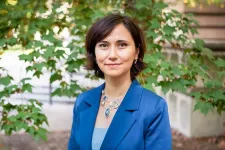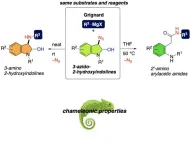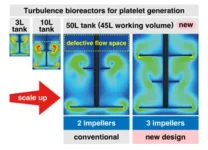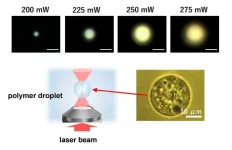The American Cancer Society estimates about 46,000 people nationally will be diagnosed this year with rectal cancer—the third most common type of cancer in the digestive system, after colon and pancreatic cancer.
By using AI, the researchers intend to derive specific metrics on magnetic resonance imaging (MRI) scans to better understand how rectal tumors are responding to therapy. The new information represents a key advance toward overcoming issues clinicians face in evaluating which tumors are dying or significantly regressing after therapy, and which are not.
“Our goal is to develop new types of radiomic signatures, involving computational analysis of radiology and pathologhy images, to determine how well these patients have responded to therapy,” said Satish Viswanath, an associate professor of biomedical engineering at Case Western Reserve and the grant’s lead researcher. “By doing so, doctors will be able to better personalize treatments for patients with rectal cancer.”
The study will analyze medical images from more than 900 rectal cancer patients using AI, a new biology-driven radiomics approach. The research will also include data collected in a previous clinical trial of rectal cancer patients.
Investigators will analyze how well patients respond to treatment based on the information gathered. Their goal is to develop a non-invasive and accurate method to identify rectal cancer patients who have no tumor remaining after therapy, reducing the number of unnecessary surgeries and associated complications for these patients.
“This study has great potential to help uncover signatures of dying tumors by mining characteristics that are usually invisible to the naked eye,” said Andrei S. Purysko, associate professor of radiology at Cleveland Clinic Lerner College of Medicine and co-principal investigator. “We will also be integrating AI with clinical evaluation to work out how to make AI signatures part of the clinical workflow.”
Viswanath’s team will lead the work with support from the new Center for AI Enabling Discovery in Disease Biology at the CWRU School of Medicine, bringing together medical science and AI.
School of Medicine Dean Stan Gerson recently announced the new center, also being co-led by Viswanath, as an extension to the school’s mission to improve human health through scientific discovery and education.
“This study will bring real survival and quality-of-life benefits to our rectal cancer patients and is the first of many to come from the new center,” Gerson said. “This partnership proves how essential it is for medical institutions and disciplines to join forces and come up with new therapeutic methods for our cancer patients.”
Emily Steinhagen, a colorectal surgeon at University Hospitals Seidman Cancer Center and co-principal investigator, also leads the team with colleagues from the radiology, pathology, oncology, biostatistics and surgery departments at CWRU, Cleveland Clinic, UH and Medical College Wisconsin.
“The ability to accurately evaluate response to chemotherapy and radiation will help us personalize care by appropriately selecting them for non-operative management, and the findings of this study will help us improve outcomes for all patients being treated for rectal cancer,” Steinhagen said.
###
Case Western Reserve University is one of the country's leading private research institutions. Located in Cleveland, we offer a unique combination of forward-thinking educational opportunities in an inspiring cultural setting. Our leading-edge faculty engage in teaching and research in a collaborative, hands-on environment. Our nationally recognized programs include arts and sciences, dental medicine, engineering, law, management, medicine, nursing and social work. About 6,000 undergraduate and 6,300 graduate students comprise our student body. Visit case.edu to see how Case Western Reserve thinks beyond the possible.
About Cleveland Clinic
Cleveland Clinic is a nonprofit multispecialty academic medical center that integrates clinical and hospital care with research and education. Located in Cleveland, Ohio, it was founded in 1921 by four renowned physicians with a vision of providing outstanding patient care based upon the principles of cooperation, compassion and innovation. Cleveland Clinic has pioneered many medical breakthroughs, including coronary artery bypass surgery and the first face transplant in the United States. Cleveland Clinic is consistently recognized in the U.S. and throughout the world for its expertise and care. Among Cleveland Clinic’s 81,000 employees worldwide are more than 5,743 salaried physicians and researchers, and 20,160 registered nurses and advanced practice providers, representing 140 medical specialties and subspecialties. Cleveland Clinic is a 6,690-bed health system that includes a 173-acre main campus near downtown Cleveland, 23 hospitals, 276 outpatient facilities, including locations in northeast Ohio; Florida; Las Vegas, Nevada; Toronto, Canada; Abu Dhabi, UAE; and London, England. In 2023, there were 13.7 million outpatient encounters, 323,000 hospital admissions and observations, and 301,000 surgeries and procedures throughout Cleveland Clinic’s health system. Patients came for treatment from every state and 132 countries. Visit us at clevelandclinic.org. Follow us at twitter.com/CleClinicNews. News and resources available at newsroom.clevelandclinic.org. Editor’s Note: Cleveland Clinic News Service is available to provide broadcast-quality interviews and B-roll upon request.
About University Hospitals / Cleveland, Ohio
Founded in 1866, University Hospitals serves the needs of patients through an integrated network of 21 hospitals (including five joint ventures), more than 50 health centers and outpatient facilities, and over 200 physician offices in 16 counties throughout northern Ohio. The system’s flagship quaternary care, academic medical center, University Hospitals Cleveland Medical Center, is affiliated with Case Western Reserve University School of Medicine, Northeast Ohio Medical University, Oxford University, the Technion Israel Institute of Technology and . National Taiwan University College of Medicine. The main campus also includes the UH Rainbow Babies & Children's Hospital, ranked among the top children’s hospitals in the nation; UH MacDonald Women's Hospital, Ohio's only hospital for women; and UH Seidman Cancer Center, part of the NCI-designated Case Comprehensive Cancer Center. UH is home to some of the most prestigious clinical and research programs in the nation, with more than 3,000 active clinical trials and research studies underway. UH Cleveland Medical Center is perennially among the highest performers in national ranking surveys, including “America’s Best Hospitals” from U.S. News & World Report. UH is also home to 19 Clinical Care Delivery and Research Institutes. UH is one of the largest employers in Northeast Ohio with more than 30,000 employees. Follow UH on LinkedIn, Facebook and Twitter. For more information, visit UHhospitals.org.
END










